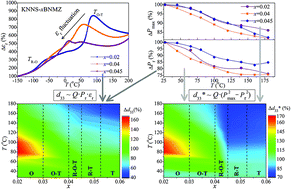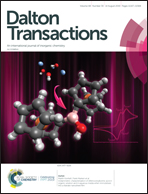Polymorphic characteristics challenging electrical properties in lead-free piezoceramics
Abstract
Temperature-dependent polymorphic phase transition in (K, Na)NbO3 (KNN) inevitably causes the fluctuation of their electrical properties with temperature variation. Here, we investigate the temperature-sensitive electrical properties and their structure/physical origins in a paradigm KNN-based piezoceramic. The orthorhombic–tetragonal (O–T) phase transition exhibits a degenerate dielectric anomaly when it moves to a low temperature, as the consequence of diffused phase transition caused by local chemical heterogeneity after adding additives. In this case, electric field-induced maximum and remnant polarization show different variations. Consequently, the elevation of the piezoelectric coefficient (d33 and  ) was obviously observed when the temperature goes through the O–T phase transition. We found that elevated d33 principally comes from the dielectric anomaly, and
) was obviously observed when the temperature goes through the O–T phase transition. We found that elevated d33 principally comes from the dielectric anomaly, and  fluctuation is mainly attributed to the distinct degeneration between the maximum and remnant polarization. The best strategy for optimizing piezoelectric stability is to shift O–T to near room temperature to form rhombohedral (R)–O–T or R–T phase boundaries and make the phase transition a diffused process in a wide temperature range. For example, the high and temperature-insensitive d33 (∼385 pC N−1) and
fluctuation is mainly attributed to the distinct degeneration between the maximum and remnant polarization. The best strategy for optimizing piezoelectric stability is to shift O–T to near room temperature to form rhombohedral (R)–O–T or R–T phase boundaries and make the phase transition a diffused process in a wide temperature range. For example, the high and temperature-insensitive d33 (∼385 pC N−1) and  (∼480 pm V−1 at 30 kV cm−1) were achieved in the R–O–T region and changed less than 10% when temperature is elevated from room temperature to 80 °C in this KNN paradigm. Our work affords significant guidance for optimizing temperature stability in KNN-based systems.
(∼480 pm V−1 at 30 kV cm−1) were achieved in the R–O–T region and changed less than 10% when temperature is elevated from room temperature to 80 °C in this KNN paradigm. Our work affords significant guidance for optimizing temperature stability in KNN-based systems.



 Please wait while we load your content...
Please wait while we load your content...